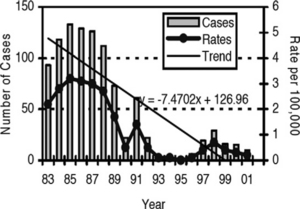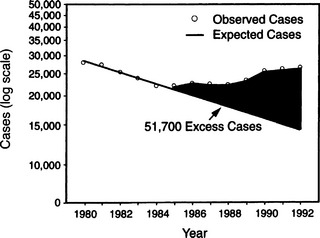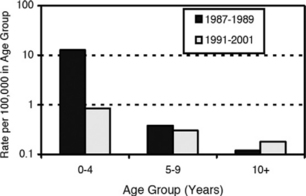CHAPTER 1 Measures of Disease
INCIDENCE AND PREVALENCE
Diseases can be measured by quantifying the incidence rates at which they occur. The word rate implies that something is happening over time. Incidence is defined as the number of new cases of a disease that occur over a certain period of time, usually 1 year, divided by the number of people at risk. For example, if 15 people develop influenza out of 100 who are exposed over a year, the incidence of new cases of influenza is 0.15/year. Because incidence measures the occurrence of an event (disease) over time, it is a measurement of the risk of getting the disease if you belong to the population.
• Incidence is the number of new cases of a disease divided by the number of people at risk for the disease, over a given period of time.
Incidence is used to track the baseline rates of disease and to measure the effectiveness of prevention programs such as immunizations. Hemophilus influenzae is a bacterium that can cause meningitis and epiglottis in young children. These are both potentially life-threatening illnesses. When the Hemophilus influenzae vaccination was introduced, the incidence of these diseases was markedly decreased (Figure 1-1). In addition to an overall decline in incidence, a shift was observed in the average age of presentation of these diseases—from very young children who were now protected by the vaccination, to older children who had not been immunized (Figure 1-2). If the incidence of a disease has been tracked for several years, we know its baseline rate. We do not expect a big change from year to year. If this happens, it triggers an investigation into the cause so we may intervene to prevent a worsening epidemic. In the mid 1980s, an alarming increase occurred in the incidence of tuberculosis (Figure 1-3) which alerted health care officials to an impending epidemic. Previously it seemed that tuberculosis was on its way to being suppressed in the United States because of the public health efforts that were in effect to control it. The increased incidence was partially attributed to the emergence of human immunodeficiency virus (HIV) infection, which increases one’s susceptibility to tuberculosis. This observation led to increased efforts to identify the affected individuals and ensure that they were treated.

FIGURE 1-1 Hemophilus influenzae-caused cases and incidence rates, Louisiana, 1983–2001.
(From www.oph.dhh.louisiana.gov)

FIGURE 1-3 Expected and observed number of tuberculosis cases, United States, 1980–1992.
(From Centers for Disease Control and Prevention. 1993. MMWR, 42:696.)
Prevalence, on the other hand, is the number of persons affected with a disease compared to the number of persons in the population who could have the disease, at any given time. It does not account for the duration of the disease. It is like looking at a slice of the population at a point in time to see who has the disease and who does not. Since it does not identify the new cases, it is not a measure of risk, but it does reflect the burden of disease on the community.
Stay updated, free articles. Join our Telegram channel

Full access? Get Clinical Tree



